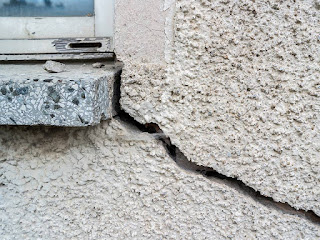 |
| Source: Simply Business |
When I first graduated from University I joined a Property Consultancy who’s main area of business was dealing with subsidence insurance claims as Loss Adjusters. My role was to visit site with a more experienced Structural Engineer, who would make an initial assessment, and then I would be required to manage the claim to a conclusion. This often involved crack monitoring to establish whether any movement was historic (had now stopped) or progressive (was still continuing). This was a crucial part of the process as it is pointless dealing with the effect of subsidence until movement has been stopped. On the occasions where movement was found to be progressive, it was sometimes first necessary to undertake substantial remedial work such as underpinning to stabilise the building. In these instances, the whole process could be lengthy and disruptive for the residents and in some cases required temporarily decanting of the occupants to alternative accommodation for the duration of the works. Most home insurance policies will cover subsidence risk and incorporate an excess payment in the region of £1000 (always check the wording of your policy because there can be variations). This demonstrates that the effects of subsidence can be disruptive and even though it may be covered by home insurance it can still be expensive.
 |
| Source: own |
Building design should involve careful consideration of the type/load of the building, the type of foundation used and ground bearing capacity and nature of the ground, the height of the water table and so on. These types of investigations should help to ensure that once the building is complete and occupied that it does not move! Subsidence however is not the same as settlement. Settlement usually occurs in new or relatively new buildings. As buildings are very heavy they cause the ground to compact, although this will usually stop after a short period of time. Also, most buildings are constructed in a variety of materials, all of which need to settle and in addition will have different rates of shrinkage. Subsidence occurs when for some reason the load bearing capacity of the ground that a building is placed upon is no longer capable of accommodating that load. The reasons for the change is the load bearing capacity is impacted and this can occur for many different reasons and in some cases, many years after the building was first completed. It is quite feasible for a building to sit quite happily on a piece of ground for many years and due to some of the influences discussed it part 2 of this article, it can start to move.
Cracking in buildings occurs for many different reasons so it is fundamentally important that anyone who undertakes inspections or gives advice in respect of cracking should not make rash judgements and should gather all of the evidence before arriving at a possible cause. In order to aid the inspector, which as stated previously, can be a Building Surveyor, it might be necessary to recommend other investigations such as geo-technical surveys to establish ground type, composition, contaminants etc., trial holes to establish foundation depths, CCTV inspection of the drainage system and possibly an arboricultural survey to give advice on any trees that may be an influencing factor. The choice of which investigations are needed will be decided once the inspector has made an initial assessment of the cracking. Therefore, when you see cracking in a building it will not always be, in-fact is unlikely to be subsidence however, this can only be established through a comprehensive building survey and detailed investigations.
In Part 2 of this article I will discuss subsidence in more detail and provide information of the things a Building Surveyor will look at to identify when and how subsidence is occurring as well as indicators that may suggest that subsidence can occur in the future.
Author: Gary O’Neill
Please feel free to share this article and other articles on this site with colleagues, friends and family who you think would be interested
Information/opinions posted on this site are the personal views of the author and should not be relied upon by any person or any third party without first seeking further professional advice. Also, please scroll down and read the copyright notice at the end of the blog.









